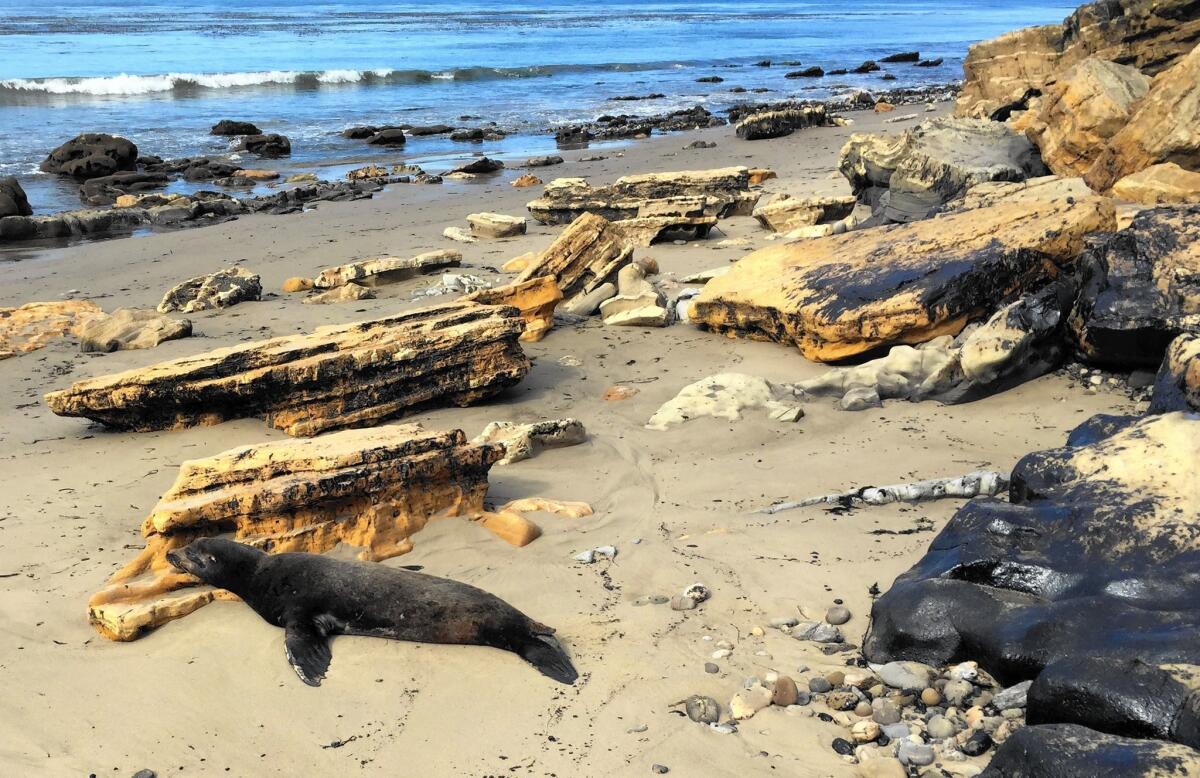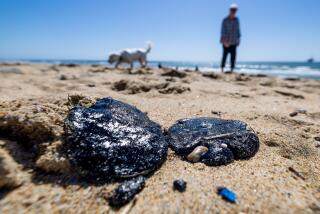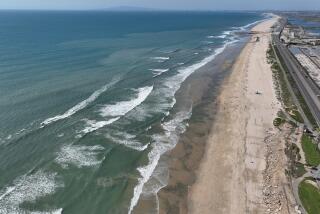Crews work to assess, control Santa Barbara-area oil spill

A sea lion covered in oil struggles on the sand just west of El Refugio State Beach, about 100 feet from where the oil spill flowed into the ocean.
Efforts to clean the crude-stained Santa Barbara coastline ramped up Thursday as scientists, government officials and workers tried to get a handle on the size, extent and environmental impact of Tuesday’s oil spill.
Officials responding to the spill, which sent an estimated 21,000 gallons of oil into the water near Refugio State Beach, asked for patience as the massive cleanup effort turned into a 24-hour operation with some 300 workers and 18 boats.
Investigators were still working Thursday to determine the cause of the spill from Plains All American Pipeline.
“Cleanup doesn’t happen overnight,” Capt. Jennifer Williams of the U.S. Coast Guard said at a news conference. “You may see some progress early on, maybe in the first week or two. ... But these types of things continue on for perhaps even months.”
Throughout the day, fish and marine animals covered in oil were being recovered by state officials. At one point, a shiny, oil-stained junior sea lion washed up on the beach, collapsing about 100 feet from the site of the oil pipeline break. The animal rested its head on a rock and rolled onto its back, exposing its shiny black oil-stained belly.
“That poor sea lion really puts it all into perspective,” said Anna James, a UC Santa Barbara marine sciences doctoral student who had been taking water samples nearby.
As an environmental scientist with the Department of Fish and Wildlife approached the sea lion, it rose up on its flippers and shuffled back toward the water, eventually disappearing into the surf.
Experts describe the spill as moderate in size but have said it still could have a dramatic impact in an environmentally sensitive area such as the Gaviota Coast. The region hosts rare seabirds, migrating whales, sea lions, dolphins and other marine mammals. It is also home to two state Marine Protected Areas that safeguard sea life.
“They’ll clean the beaches, everything that’s visible, but there will be organisms that take up oil, there will be oil under the rocks and oil that percolates down into the sand and sediment, and the state should monitor that for long-term effects,” said Phyllis Grifman, associate director of the USC Sea Grant Program.
State Fish and Wildlife officials said they recovered five brown pelicans that were still alive. They also found dead kelp bass, lobsters and other marine life covered in oil. The agency rescued a juvenile sea lion found with more than a third of its body covered in crude. The animal was transferred to SeaWorld for rehabilitation.
The agency doesn’t yet have official numbers on other wildlife rescued or recovered.
Fish and Wildlife Capt. Mark Crossland said that 15 trained scientists were searching land and sea for oil-injured animals.
A slick generated by the spill has spread across more than nine square miles of water near the shore, scientists said, with the oil stretching roughly from Arroyo Hondo Creek down to El Capitan State Beach. Federal officials overseeing the response to the spill said some of the oil will naturally dissipate, some will emulsify and some will sink beneath the ocean surface.
The most serious oil damage has occurred along roughly four miles of coastline centered around Refugio State Beach, where heavy, viscous oil has thickly coated rocks, sand and shoreline organisms, said Dave Valentine, a professor of microbiology and geochemistry at UC Santa Barbara who was assessing the spill’s impacts by boat Thursday. About eight miles offshore, Valentine saw 1,000 to 2,000 pancake-sized globs of oil.
“It’s bad news for the beach. It’s localized to that roughly four-mile area, but the impacts appear to be significant to the biological communities that live on the beach,” said Valentine, who has studied oil spills for 20 years and worries about the less-visible effects of the spill on the seafloor. “The impacts are not because of its size so much as its proximity to shore.”
Federal officials said Thursday afternoon that they had recovered more than 8,358 gallons of oil and water using skimmer vessels and more than 4,500 feet of boom, floating barriers used to contain an oil slick.
On the shoreline, workers scooped up contaminated sand and scraped oil off large rocks as pelicans flew overhead. Workers also began excavating dirt along the path of the oil spill, piling oil-saturated sand into large plastic bags.
The spill could result in $500,000 to $2 million in penalties against the pipeline operator, Plains All American Pipeline, under the Clean Water Act, legal experts said.
Under federal law, the company also will be responsible for the cost of cleaning up the oil spilled and restoring environmental damage.
The U.S. Environmental Protection Agency is gathering information that could lead to Clean Water Act penalties, spokeswoman Nahal Mogharabi said. The company could be assessed fines of $37,500 per violation per day, or $1,100 per barrel of oil spilled, she said.
The most recent large oil spill in California occurred in 2007 after a container ship struck the Bay Bridge, releasing 53,000 gallons of fuel oil into San Francisco Bay and killing thousands of birds.
The companies responsible for that spill settled with federal, state and local officials for $44.4 million.
Times staff writer Monte Morin contributed to this report.
More to Read
Sign up for Essential California
The most important California stories and recommendations in your inbox every morning.
You may occasionally receive promotional content from the Los Angeles Times.












